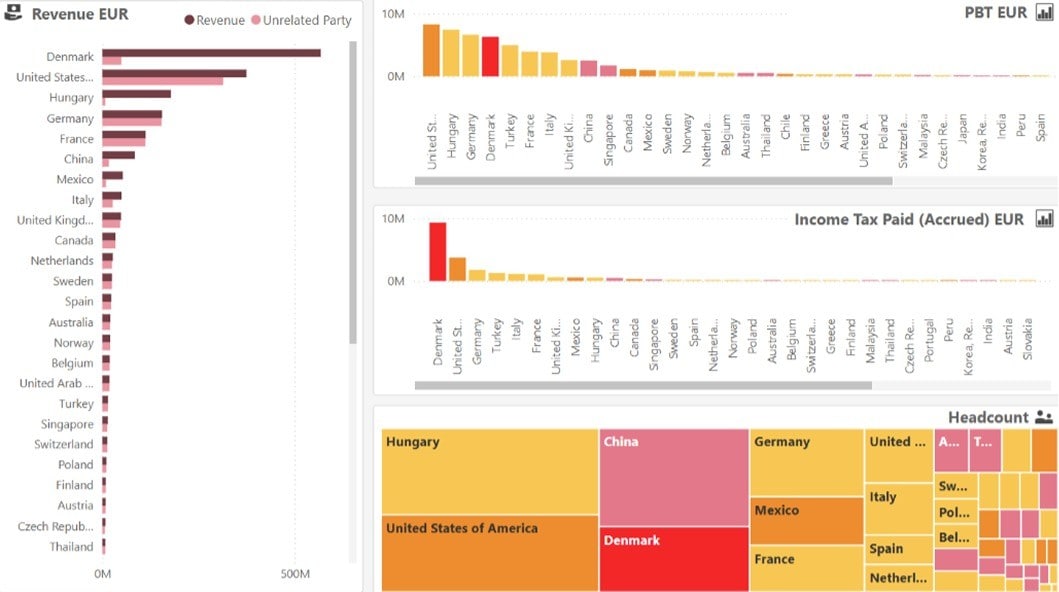Multinational enterprises (MNEs) are faced with increasing pressure to disclose detailed financial and tax information on a country-by-country basis. This is where our advanced Public Country-by-Country Reporting (CbCR) Dashboard Tool comes into play, designed to help you navigate the complexities of public CbCR requirements and ensure compliance with the latest regulations.
Why Public CbCR Matters
Public CbCR is a transparency initiative aimed at enhancing openness by requiring MNEs to disclose key financial and tax on a country-by-country basis. The purpose of the reporting is for the stakeholders of MNE’s to gain insight into the MNE’s tax position based on information on the MNE’s economic presence and tax contributions on a jurisdictional level. However, the requirements for public CbCR can vary across different jurisdictions, posing a challenge for multinational groups to ensure compliance across the regulations for public CbCR.
Understanding the Requirements
EU Public CbCR Requirements
The European Union has introduced stringent requirements for large multinational companies to publicly disclose information on where their profits arise and where these are ultimately taxed. The disclosure requirements are broadly similar to the OECD BEPS template and include the following data points per jurisdiction:
- Total revenue
- Profit/loss before tax
- Corporate income tax paid and accrued
- Number of employees
- Total accumulated earnings
- Brief description of the nature of business activities
MNEs with global consolidated revenues of over EUR 750 million for each of the last two financial years are in scope. The first reports are expected for financial years beginning on or after 22 June 2024.
Specific EU Member States have implemented the directive ahead of the 22 June 2023 transposition deadline. For instance, Romania has already introduced public CbC reporting obligations effective from 1 January 2023. Other countries like the Netherlands, Hungary, Germany, Finland, Ireland, and Sweden have also announced their implementation plans, with some opting for earlier dates.
Australian Public CbCR Requirements
Australia has also implemented a public CbCR regime, requiring large MNEs to disclose selected tax information on a country-by-country basis. The regime applies for reporting periods commencing from 1 July 2024. The information must be reported either on a CBC basis or on an aggregated basis and includes:
- Name of the jurisdiction
- Description of main business activities
- Number of employees (full-time equivalent)
- Revenue from unrelated parties
- Revenue from related parties
- Profit or loss before income tax
- Book value of tangible assets (excluding cash and cash equivalents)
- Income tax paid (on a cash basis)
- Income tax accrued (current year)
- Reasons for differences in income tax
- Currency used
Entities must report if they meet specific criteria, including being a Public CbCR reporting parent and having a consolidated net turnover of AUD 10 million or more of Australian-sourced income. The first publication is expected to be released in late 2026.
Comparison of EU, OECD, GRI and Australian Public CbCR Requirements
Data Point |
GRI 207-4 | OECD |
EU pCbCR |
Australian pCbCR |
Total revenue |
🗴 |
✓ |
✓ |
🗴 |
Revenue from third parties |
✓ |
✓ |
🗴 |
✓ |
Revenue from related parties |
Between jurisdictions only |
✓ |
🗴 |
✓ |
Profit/loss before tax |
✓ |
✓ |
✓ |
✓ |
Cash tax paid |
✓ |
✓ |
✓ |
✓ |
Tax accrued |
✓ |
✓ |
✓ |
✓ |
Tangible assets other than cash and cash equivalents |
✓ |
✓ |
🗴 |
✓ |
Number of employees |
✓ |
✓ |
✓ |
✓ |
Reasons for the difference between accrued CIT and statutory rate |
✓ |
🗴 |
🗴 |
✓ |
Total accumulated earnings |
🗴 |
✓ |
✓ |
🗴 |
Stated capital |
🗴 |
✓ |
🗴 |
🗴 |
Why Choose Our Public CbCR Dashboard Tool?
Our advanced tool is designed to meet the diverse requirements of multiple jurisdictions, including the EU and the ATO, ensuring your compliance and providing valuable insights into your tax data. Here are some key benefits of using our CbCR data analysis tool:
- Key Ratio Analysis and Risk Assessment: Early detection of potential communication areas.
- Increased Transparency: Enhanced visibility for the tax department and other stakeholders.
- Timely Compliance: Ensures you meet mandatory EU and ATO compliance deadlines.
- Data Visualization: Beyond standard tax reporting, enabling comprehensive analysis of financial and tax data.
- 24/7 Access: User-friendly format accessible anytime, anywhere.



Get Started Today
Don't wait until the last minute to prepare for public CbCR. Our advanced dashboard tool is your one-stop solution for ensuring compliance with the latest regulations and gaining valuable insights into your tax data. Contact us today to learn more about how we can help you navigate the complexities of public CbCR and enhance your tax transparency.
Contact us
Partner, Transfer Pricing and Head of Tax Technology & Transformation, København, PwC Denmark
2939 2465
Oliver Lundgreen Kollerup
Luis Ernesto Taborda Moreno





